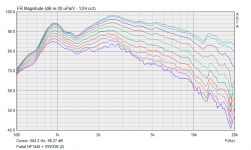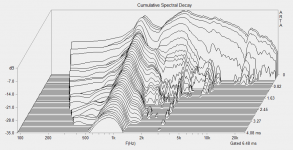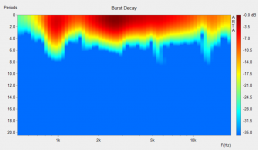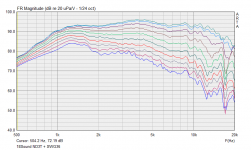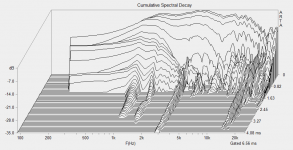Think "vuvusela".... thet vibrate your hands like crazy... https://www.google.com/url?sa=t&rct...=bKCIFXqhLzo&usg=AOvVaw1YJFvor5CEUjFJ5kj571fG
//
//
- But as I've just learned, they can't make it in the required thickness and guarantee the quality, so probably this is the end of it anyway. I can't risk it to be too flimsy.
Would it be an option for you to have them produced in Asia, i. e. with a contractor or another company? P.audio produces a copy of JBL 2342 horn, and they can offer it cheap. DIYSoundGroup had the SEOS waveguides produced in bigger batches too, only problem for them being the relative popularity of SEOS-12 vs. SEOS-10, so rumor has it there is still plenty of fixed capital in form of the less demanded waveguide. Not a problem with only one product. I never understood it that you want to produce them individual and yourself. It will then in any case always be a production charge. I'm still confident that this can be done with a kickstarter or something similar.
On a more serious note; there is post #7415 which indicate an impact. I can't judge the absorption number vs material floppiness... I would think stiff/hard is the preferred direction if ringing can be controlled.
Maybe a half finished product which is to be filled by the user with something heavy like concrete etc...
//
Maybe a half finished product which is to be filled by the user with something heavy like concrete etc...
//
Last edited:
Well I definitely want and still move towards making waveguides by myself, with a CNC machine I designed, constructed and wrote software for - that's my hobby I still like doing, i.e. making it primarily for me, where I don't look much at the costs and the labour (and tastes of anyone else, for that matter). And honestly, I don't believe there's a market for this, even if there was a way how to make it cheaply. Sand printing and aluminum casting are the current options, immediately available to those willing to pay for it. Can't promise anything else. I'm really not that interested in doing so. It would be just nice to see these waveguides spreading in the audio community, because they are really good - that's about all 🙂
Last edited:
I don't believe there's a market for this, even if there was a way how to make it cheaply.
Cheap enough and then "maybe" there is a market, but everyone wants something different (a dozen different designs!?) You will never get agreement on "just one" to make.
To go cheap enough you would have to go to China, but that's a BIG step. You'd have to commit to 100's/1000's and pay half down and then wait six to nine months for delivery .. and then where do you put them? (and let's hope you found the honest guy!)
Been down this road before. I have lot's of contacts in China and I was never able to see a business model that would work.
I agree that waveguide vibrations is not going to be a factor with the kinds of drivers we use these days. But older TAD 2" drivers cantilevered out on a weak waveguide and that would concern me. A 1" neo - not at all.
Last edited:
Well I definitely want and still move towards making waveguides by myself, with a CNC machine I designed
Have you considered vacuum molding? Since you have a CNC you can manufacture your own plug out of MDF and trim the sheet material once formed.
Regarding vibrations
Some dedicated dipole/open baffle folk use 'swings' to prevent transmission of LF driver vibrations to mid and HF drivers.
If HF isolation from LF vibrations was deemed to be important, a swing mount for the freestanding horn assembly could be devised.
Actually, these were Chinese, willing to make even as few as 50 pieces (10 of those as free samples in advance). I would be never able to get such a low quotation for the mold locally (many times more, making it all unfeasible).To go cheap enough you would have to go to China, but that's a BIG step. You'd have to commit to 100's/1000's and pay half down and then wait six to nine months for delivery .. and then where do you put them? (and let's hope you found the honest guy!)
Been down this road before. I have lot's of contacts in China and I was never able to see a business model that would work.
That's also the difference with a free standing device I see - the waveguide doesn't have to support/hold the driver, it can be the other way around, the driver can be clamped to something robust in the first place. I can imagine a free standing aluminum guide ringing like hell when hit with e.g. a steel rod, but would these resonances get excited during a regular playback to a perceptible level? A similar situation is with the sand printed (expoxy coated) waveguides - they are far from dead (this was a bit dissapointing at first to me) but I couldn't measure any resonances I could attribute to the waveguide when driven with the sound alone (looking at the decay trace). That makes me a little optimistic about that.I agree that waveguide vibrations is not going to be a factor with the kinds of drivers we use these days. But older TAD 2" drivers cantilevered out on a weak waveguide and that would concern me. A 1" neo - not at all.
Last edited:
You say it as if the molding itself was the easy part 🙂 I considered that before, there are several companies around that can do it. That would be probably the cheapest option, but then, it's still only a semi-finished product, and still a pretty lousy one, I'm afraid. For baffle mounted, I would consider it seriously, as clamping the mouth makes it a lot more sturdy. For free standing, I'm not so sure, it's still only one layer of relatively thin sheet. Wouldn't look very good, IMHO.Have you considered vacuum molding? Since you have a CNC you can manufacture your own plug out of MDF and trim the sheet material once formed.
Last edited:
Kind of reminds me a Le Cléac'h horn.Think "vuvusela".... thet vibrate your hands like crazy... https://www.google.com/url?sa=t&rct...=bKCIFXqhLzo&usg=AOvVaw1YJFvor5CEUjFJ5kj571fG
My first measurement of Faital HF1440 on the test jig (#7299). I think it will shine in a large waveguide. Measured SPL for the both pieces I have.
Attachments
18Sound ND3T on the same jig
- I guess there must be something wrong with the Faitals. 😕
Has anyone else measured them already?
- I guess there must be something wrong with the Faitals. 😕
Has anyone else measured them already?
Attachments
Last edited:
Legis ran into similar issues when comparing the HF1440 to a TAD4001.
A little eq shouldn't hurt too much.
A little eq shouldn't hurt too much.
I agree about EQ but it's definitely not advertised - FaitalPRO | HF Drivers | HF1440 (8Ω)
At first I thought it may be the "waveguide" but obviously it isn't.
Otherwise I like the smoothness a lot, not typical for a big 1.4" driver.
At first I thought it may be the "waveguide" but obviously it isn't.
Otherwise I like the smoothness a lot, not typical for a big 1.4" driver.
Last edited:
so when it comes to smoothness is it that the graph looks good or is it a judgment made from hearing them both????
Above 10khz looks similar to what I've seen from the ND3SN.
The top octave is impressive on the Faital.
Curious how they compare subjectively.
The top octave is impressive on the Faital.
Curious how they compare subjectively.
My first measurement of Faital HF1440 on the test jig (#7299). I think it will shine in a large waveguide. Measured SPL for the both pieces I have.
At what distance and voltage are these measurements done?
- Home
- Loudspeakers
- Multi-Way
- Acoustic Horn Design – The Easy Way (Ath4)

